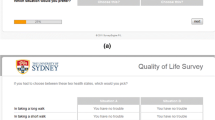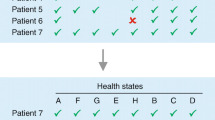Abstract
Background: Preference-based measures of health (PBMH) provide ‘preference’ or ‘utility’ weights that enable the calculation of QALYs for the economic evaluations of interventions. The Diabetes Utility Indexê (DUI) was developed as a brief, self-administered, diabetes mellitusspecific PBMH that can efficiently estimate patient-derived health state utilities.
Objective: To describe the development of the valuation function for the DUI, and to report the validation results of the valuation function.
Methods: Multi-Attribute Utility Theory (MAUT) was used as the framework to develop a valuation function for the DUI. Twenty of 768 possible health states of the DUI classified as anchor states, single-attribute level states including corner states, and marker states were selected and described for preference elicitation interviews. Visual analogue scale and standard gamble (SG) exercises were used to measure preferences from individuals with diabetes recruited from primary care and community settings in and around Morgantown, WV, USA for the 20 health states defined by combinations of DUI attributes and severity levels. Data collected in the interviews were used to develop a valuation function that calculates utilities for the DUI health states and calculates attribute-level utilities. A validation survey of the valuation function was conducted in collaboration with the West Virginia University (WVU) Diabetes Institute.
Results: A total of 100 individuals with diabetes were interviewed and their preferences for various DUI health states measured. From data generated in the interviews, a DUI valuation function was developed on a scale where 1.00 = perfect health (PH) and 0.00 = the all worse pits state, and adjusted to yield utilities on the conventional scale 1.00 =PH and 0.00 = dead.
A total of 396 patients with diabetes who received care at WVU clinics completed a DUI mail validation survey (response rate = 33%). Clinical data consisting of International Classification of Diseases, 9th edition, diagnosis codes and glycosylated haemoglobin (HbA1c) values for the respondents were merged with their responses to the DUI. The utilities calculated by the scoring function of the DUI compared favourably to cardinal SG utilities for three DUI health states for which both assessments were available. The DUI utility function slightly underestimated actual SG utilities for mild and moderate health states (mean absolute difference = 0.05).
There was a small but significant correlation between DUI utility scores and average past year HbA1c values (r=-0.30; p < 0.001). Respondents with two or more complications had significantly lower DUI utilities than those with no complications (p < 0.001) or one complication (p = 0.015). Insulin users had significantly lower DUI utilities than non-users (p < 0.001), and those with HbA1c values <7% had significantly higher DUI utilities than those with HbA1c values of 7% (p < 0.001). No significant association was found between DUI scores and age or sex.
Conclusion: These results show evidence of the feasibility and validity of the DUI. Further research is suggested to demonstrate the generalizability of these findings, to study the responsiveness of the DUI, and to examine the clinical meaningfulness of DUI change scores.






Similar content being viewed by others
References
Gold MR, Patrick DL, Torrance GW, et al. Identifying and valuing outcomes. In: Gold MR, Siegel JE, Russell LB, et al., editors. Cost-effectiveness in health and medicine. New York: Oxford University Press, 1996: 82–134
Drummond MF, O’Brien BJ, Stoddart GL, et al. Costutility analysis: methods for the economic evaluation of healthcare programs. New York: Oxford University Press, 1997: 139–204
Feeny D, Furlong W, Boyle M, et al. Multi-attribute health status classification systems: Health Utilities Index. Pharmacoeconomics 1995; 7 (6): 490–502
Dolan P. Modeling valuations for EuroQol health states. Med Care 1997; 35 (11): 1095–108
Brazier J, Usherwood T, Harper R, et al. Deriving a preference-based single index from the UK SF-36 Health Survey. J Clin Epidemiol 1998; 51 (11): 1115–28
Froberg DG, Kane RL. Methodology for measuring healthstate preferences: II. Scaling methods. J Clin Epidemiol 1989; 42 (5): 459–71
Dolan P. The measurement of health-related quality of life. In: Culyer AJ, Newhouse J, editors. Handbook of health economics. Vol. 1B. Amsterdam: Elsevier, 2000: 1723–60
Dolan P. Modelling the relationship between the description and valuation of health states. In: Murray CJL, Salomon JA, Mathers CD, et al., editors. Summary measures of population health: concepts, ethics, measurement and applications. Geneva: World Health Organization, 2002: 510–3
Feeny D. The utility approach to assessing population health. In: Murray CJL, Salomon JA, Mathers CD, et al., editors. Summary measures of population health: concepts, ethics, measurement and applications. Geneva: World Health Organization, 2002: 515–28
Brazier J, Roberts J, Deverill M. The estimation of a preference-based measure of health from the SF-36. J Health Econ 2002; 21 (2): 271–92
Brooks R. EuroQol: the current state of play. Health Policy 1996; 37 (1): 53–72
Kind P. The EuroQoL instrument: an index of health-related quality of life. In: Spilker B, editor. Quality of life and pharmacoeconomics in clinical trials. Philadelphia (PA): Lippincott-Raven, 1996: 191–201
Torrance GW, Feeny DH, Furlong WJ, et al. Multiattribute utility function for a comprehensive health status classification system: Health Utilities Index Mark 2. Med Care 1996; 34 (7): 702–22
Feeny D, Furlong W, Torrance GW, et al. Multiattribute and single-attribute utility functions for theHealth Utilities Index Mark 3 system. Med Care 2002; 40 (2): 113–28
Kaplan RM, Anderson JP. A general health policy model: update and applications. Health Serv Res 1988; 23 (2): 203–35
Kaplan RM, Anderson JP. The general health policy model: an integrated approach. In: Spilker B, editor. Quality of life and pharmacoeconomics in clinical trials. Philadelphia (PA): Lippincott-Raven, 1996: 302–22
Brazier JE, Roberts J. The estimation of a preference-based measure of health from the SF-12. Med Care 2004; 42 (9): 851–9
Kantz ME, Harris WJ, Levitsky K, et al. Methods for assessing condition-specific and generic functional status outcomes after total knee replacement. Med Care 1992; 30 Suppl. 5: 240–52
Bombardier C, Melfi CA, Paul J, et al. Comparison of a generic and a disease-specific measure of pain and physical function after knee replacement surgery. Med Care 1995; 33 Suppl. 4: 131–44
Revicki DA, Leidy NK, Brennan-Diemer F, et al. Integrating patient preferences into health outcomes assessment: the multiattribute Asthma Symptom Utility Index. Chest 1998; 114 (4): 998–1007
Revicki DA, Leidy NK, Brennan-Diemer F, et al. Development and preliminary validation of themultiattributeRhinitis Symptom Utility Index. Qual Life Res 1998; 7 (8): 693–702
Casey R, Tarride JE, Keresteci MA, et al. The Erectile Function Visual Analog Scale (EF-VAS): a disease-specific utility instrument for the assessment of erectile function. Can J Urol 2006; 13 (2): 3016–25
Brazier JE, Roberts J, Platts M, et al. Estimating a preference-based index for a menopause specific health quality of life questionnaire. Health Qual Life Outcomes 2005; 3 (1) 13: 12–20
Beusterien K, Leigh N, Jackson C, et al. Integrating preferences into health status assessment for amyotrophic lateral sclerosis: the ALS Utility Index. Amyotroph Lateral Scler Other Motor Neuron Disord 2005; 6 (3): 169–76
Sundaram M, Smith MJ, Nath C. Development of a classification system for a diabetes-specific preference-based measure of health. Value Health 2008; 11 (3): A233
Sundaram M, Smith MJ, Revicki DA, et al. Rasch analysis informed the development of a classification system for a diabetes-specific preference-based measure of health. J Clin Epidemiol 2009 Aug; 62 (8): 845–56
Furlong W, Feeny DH, Torrance GW, et al. Multiplicative multi-attribute utility function for the Health Utilities Index Mark 3 (HUI 3): a technical report, 98-11. Hamilton (ON): Center for Health Economics and Policy Analysis, McMaster University, 1998
Keeny RL, Raiffa H. Decisions with multiple objectives: preferences and value trade-offs. 1st ed. New York: John Wiley & Sons, 1976
Keeny RL, Raiffa H. Decisions with multiple objectives: preferences and value trade-offs. 2nd ed. New York: Cambridge University Press, 1993
Torrance GW, Boyle MH, Horwood SP. Application of multi-attribute utility theory to measure social preferences for health states. Oper Res 1982; 30 (6): 1043–69
Torrance GW, Furlong W, Feeny D, et al. Multi-attribute preference functions: Health Utilities Index. Pharmacoeconomics 1995; 7 (6): 503–20
Torrance GW, Feeny D, Furlong W. Visual analog scales: do they have a role in the measurement of preferences for health states? Med Decis Making 2001; 21 (4): 329–34
von Neumann J, Morgenstern O, Rubinstein A. Theory of games and economic behavior. Princeton (NJ): Princeton University Press, 2004
Furlong W, Feeny DH, Torrance GW, et al. Guide to design and development of health state utility instrumentation. Hamilton (ON): Center for Health Economics and Policy Analysis, McMaster University, 1990
Lau CY, Qureshi AK, Scott SG. Association between glycaemic control and quality of life in diabetes mellitus. J Postgrad Med 2004; 50 (3): 189–93
Sundaram M, Kavookjian J, Patrick JH, et al. Quality of life, health status and clinical outcomes in type 2 diabetes patients. Qual Life Res 2007; 16 (2): 165–77
Polonsky WH, Anderson BJ, Lohrer PA, et al. Assessment of diabetes-related distress. Diabetes Care 1995; 18 (6): 754–60
Nerenz DR, Repasky DP, Whitehouse FW, et al. Ongoing assessment of health status in patients with diabetes mellitus. Med Care 1992; 30 (5 Suppl.): MS112–24
Guttmann-Bauman I, Flaherty BP, Strugger M, et al. Metabolic control and quality-of-life self-assessment in adolescents with IDDM. Diabetes Care 1998; 21 (6): 915–8
Sundaram M, Kavookjian J, Patrick JH. Health-related quality of life and quality of life in type 2 diabetes: relationships in a cross-sectional study. Patient 2009; 2 (2): 121–33
Lloyd A, Sawyer W, Hopkinson P. Impact of long-term complications on quality of life in patientswith type 2 diabetes not using insulin. Value Health 2001; 4 (5): 392–400
Weinberger M, Kirkman MS, Samsa GP, et al. The relationship between glycemic control and health-related quality of life in patients with non-insulin-dependent diabetes mellitus. Med Care 1994; 32 (12): 1173–81
Maddigan SL, Feeny DH, Johnson JA. Construct validity of the RAND-12 and Health Utilities Index Mark 2 and 3 in type 2 diabetes. Qual Life Res 2004; 13 (2): 435–48
Petrillo J, Cairns J. Converting condition-specific measures into preference-based outcomes for use in economic evaluation. Expert Rev Pharmacoecon Outcomes Res 2008; 8 (5): 453–61
Dowie J. Decision validity should determine whether a generic or condition-specific HRQOL measure is used in health care decisions. Health Econ 2002; 11 (1): 1–8
Siegel JE, Weinstein MC, Russell LB, et al. Recommendations for reporting cost-effectiveness analyses. Panel on Cost-Effectiveness in Health and Medicine. JAMA 1996; 276 (16): 1339–41
Weinstein MC, Siegel JE, Gold MR, et al. Recommendations of the Panel on Cost-effectiveness in Health and Medicine. JAMA 1996; 276 (15): 1253–8
Russell LB, Gold MR, Siegel JE, et al. The role of costeffectiveness analysis in health and medicine. Panel on Cost-Effectiveness in Health and Medicine. JAMA 1996; 276 (14): 1172–7
National Institute for Health and Clinical Excellence. Guide to the methods of technology appraisal. London: NICE, 2008
Acknowledgements
The work detailed in this paper was supported by financial assistance from Eli Lilly and Company in the form of a dissertation research grant. The funding source had no influence on the design, analysis or reporting of research results. There are no known financial or other conflicts of interest between the authors of this paper and the funding source of the research.
The authors would like to express their gratitude to Bill Furlong of the HUI group for guidance in the application of the MAUT to our work. At the time of submission of this manuscript, Dr Murali Sundaram was employed as Scientist at QualityMetric Incorporated, Lincoln, Rhode Island, USA.
The DUI is protected by copyright. For further inquiries regarding the DUI, please contact Dr Murali Sundaram at doctormurali@gmail.com
Author information
Authors and Affiliations
Corresponding author
Rights and permissions
About this article
Cite this article
Sundaram, M., Smith, M.J., Revicki, D.A. et al. Estimation of a Valuation Function for a Diabetes Mellitus-Specific Preference-Based Measure of Health. Pharmacoeconomics 28, 201–216 (2010). https://doi.org/10.2165/11313990-000000000-00000
Published:
Issue Date:
DOI: https://doi.org/10.2165/11313990-000000000-00000




